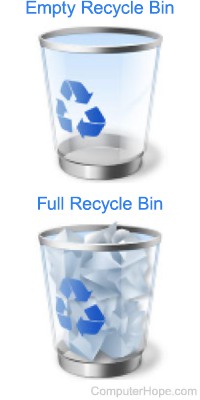How to empty or manage the Windows Recycle Bin

By default, Microsoft Windows 95 and all subsequent versions use up to 10% of your computer's available disk space to save the most recently deleted files. Its purpose is to allow users the ability to recover files that were accidentally deleted. As the Recycle Bin is filled up, older files are permanently removed from your hard drive to make space for newly deleted ones. The following sections contain information on using the Recycle Bin and its various functions.
I don't see the Recycle Bin icon
How to know if the Recycle Bin contains files
If any file is deleted in Windows, it's automatically moved to the Recycle Bin. As seen in the image, a Recycle Bin containing deleted files appears as a full wastebasket with crumpled paper, and an empty one contains nothing. Also, when an empty Recycle Bin is accessed, the message "This folder is empty" is shown.
View deleted files
Users browse these files by double-clicking the Recycle Bin icon.
How to recover files sent to the Recycle Bin
Manage the Recycle Bin capacity
To modify how much space Windows uses to store deleted files for all drives or independently, you can right-click the Recycle Bin icon and click Properties. In the Recycle Bin Properties window, you can adjust how much space the Recycle Bin takes by dragging the slider left or right, or by specifying the number of MB (megabytes). You can also completely disable the Recycle Bin feature.
When should I empty the Recycle Bin?
Emptying the Recycle Bin permanently deletes files from your hard drive. It's recommended you empty it only when you're sure you don't need the files again.
Emptying the Recycle Bin
To empty the Recycle Bin, right-click the Recycle Bin icon and select Empty Recycle Bin from the drop-down menu.
